ETH Zurich
ETH Zurich (Swiss Federal Institute of Technology in Zurich; German: Eidgenössische Technische Hochschule Zürich; French: École polytechnique fédérale de Zurich; Italian: Politecnico federale di Zurigo) is a public research university in the city of Zürich, Switzerland. Founded by the Swiss Federal Government in 1854 with the stated mission to educate engineers and scientists, the school focuses exclusively on science, technology, engineering and mathematics.[4] Like its sister institution EPFL, it is part of the Swiss Federal Institutes of Technology Domain (ETH Domain), part of the Swiss Federal Department of Economic Affairs, Education and Research.[5]
Eidgenössische Technische Hochschule (ETH) Zürich | |
 | |
Other name | Swiss Federal Institute of Technology in Zurich, German: Polytechnikum (colloquially) |
|---|---|
Former name | eidgenössische polytechnische Schule[1] |
| Type | Public |
| Established | 1855 |
| Budget | CHF 1.885 billion (2017) |
| President | Joël Mesot |
| Rector | Sarah M. Springman |
Academic staff | 6,455 (530 professors of all ranks) (full-time equivalents 2017, 29.5% female, 70.2% foreign nationals)[2] |
Administrative staff | 2,658 (full-time equivalents 2017, 42.5% female, 24.4% foreign nationals)[2] |
| Students | 20,607 (headcount 2017, 31.8% female, 38.7% foreign nationals)[2] |
| Undergraduates | 9,262[2] |
| Postgraduates | 6,158[2] |
| 4,092[2] | |
Other students | 1,095[2] |
| Address | , Zurich 47°22′35″N 8°32′53″E |
| Campus | Urban |
| Language | German, English (Masters and upwards, sometimes Bachelor) |
| Colours | Blue[3] |
| Affiliations | CESAER, EUA, GlobalTech, IARU, IDEA League |
| Website | www.ethz.ch |

In the 2021 edition of the QS World University Rankings ETH Zurich is ranked 6th in the world, and 2nd in Europe and 8th by the Times Higher Education World Rankings 2020.[6] [7] In the 2020 QS World University Rankings by subject it is ranked 4th in the world for engineering and technology (2nd in Europe) and 1st for earth & marine science.[8][9]
As of November 2019, 21 Nobel laureates, 2 Fields Medalists, 2 Pritzker Prize winners, and 1 Turing Award winner have been affiliated with the Institute, including Albert Einstein.[10] It is a founding member of the IDEA League and the International Alliance of Research Universities (IARU) and a member of the CESAER network.
History

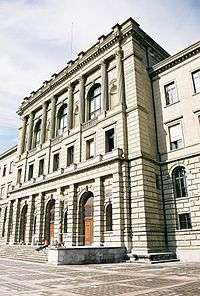
ETH was founded on 7 February 1854 by the Swiss Confederation and began giving its first lectures on 16 October 1855 as a polytechnic institute (eidgenössische polytechnische Schule) at various sites throughout the city of Zurich.[1] It was initially composed of six faculties: architecture, civil engineering, mechanical engineering, chemistry, forestry, and an integrated department for the fields of mathematics, natural sciences, literature, and social and political sciences.
It is locally still known as Polytechnikum, or simply as Poly, derived from the original name eidgenössische polytechnische Schule,[11] which translates to "federal polytechnic school".
ETH is a federal institute (i.e., under direct administration by the Swiss government), whereas the University of Zurich is a cantonal institution. The decision for a new federal university was heavily disputed at the time; the liberals pressed for a "federal university", while the conservative forces wanted all universities to remain under cantonal control, worried that the liberals would gain more political power than they already had.[12] In the beginning, both universities were co-located in the buildings of the University of Zurich.
From 1905 to 1908, under the presidency of Jérôme Franel, the course program of ETH was restructured to that of a real university and ETH was granted the right to award doctorates. In 1909 the first doctorates were awarded. In 1911, it was given its current name, Eidgenössische Technische Hochschule. In 1924, another reorganization structured the university in 12 departments. However, it now has 16 departments.
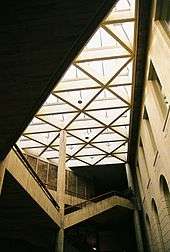
ETH Zurich, the EPFL, and four associated research institutes form the "ETH Domain" with the aim of collaborating on scientific projects.[13]
Reputation and ranking
| University rankings | |
|---|---|
| Global – Overall | |
| ARWU World[14] | 19 (2019) |
| THE World[15] | 13 (2020) |
| USNWR Global[16] | 25 (2020) |
| QS World[17] | 6 (2020) |
ETH Zurich is ranked among the top universities in the world. Typically, popular rankings place the institution as the best university in continental Europe and ETH Zurich is consistently ranked among the top 1-5 universities in Europe, and among the top 3-10 best universities of the world.
Historically, ETH Zurich has achieved its reputation particularly in the fields of chemistry, mathematics and physics. There are 32 Nobel laureates who are associated with ETH, the most recent of whom is Richard F. Heck, awarded the Nobel Prize in chemistry in 2010. Albert Einstein is perhaps its most famous alumnus.[18]
In 2018, the QS World University Rankings placed ETH Zurich at 7th overall in the world.[19] In 2015, ETH was ranked 5th in the world in Engineering, Science and Technology, just behind the Massachusetts Institute of Technology, Stanford University and Cambridge University. In 2015, ETH also ranked 6th in the world in Natural Sciences, and in 2016 ranked 1st in the world for Earth & Marine Sciences for the second consecutive year.[20]
In 2016, Times Higher Education World University Rankings ranked ETH Zurich 9th overall in the world and 8th in the world in the field of Engineering & Technology, just behind the Massachusetts Institute of Technology, Stanford University, California Institute of Technology, Princeton University, Cambridge University, Imperial College London and Oxford University.[21]
In a comparison of Swiss universities by swissUP Ranking and in rankings published by CHE comparing the universities of German-speaking countries, ETH Zurich traditionally is ranked first in natural sciences, computer science and engineering sciences.
In the survey CHE ExcellenceRanking on the quality of Western European graduate school programmes in the fields biology, chemistry, physics and mathematics, ETH was assessed as one of the three institutions to have excellent graduate programmes in all considered fields, the other two being Imperial College London and the University of Cambridge. ETH Zurich had a total budget of 1.885 billion CHF[2] in the year 2017.
Admission and education
| Swiss Federal Institutes of Technology (ETH) Domain | ||||||||
|---|---|---|---|---|---|---|---|---|
| 2019 budget (millions of CHF) | ||||||||
|
||||||||
| Federal institutes of technology | ||||||||
|
||||||||
| Federal research institutes | ||||||||
|
||||||||
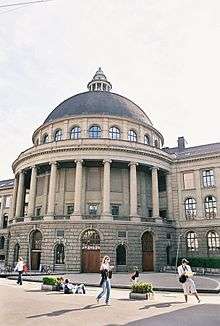
For Swiss students, ETH is not selective in its undergraduate admission procedures. Like every public university in Switzerland, ETH is obliged to grant admission to every Swiss resident who took the Matura.[22] Applicants from foreign countries are required to take either the reduced entrance exam or the comprehensive entrance exam although some applicants from several European countries are exempted from this rule. An applicant can be admitted to ETH even without any verifiable educational records by passing the comprehensive entrance exam.[23]
As at all universities in Switzerland, the academic year is divided into two semesters. Examinations are often held during examination sessions which are immediately before the beginning of the next semester (only a few select courses offer an exam immediately after the semester ends). After the first year of study, bachelor students must pass a block examination of all courses taken in the first year, called the Basisprüfung (basis examination). If the weighted average score is not sufficient, a student is required to retake the entire Basisprüfung which usually means having to re-sit the whole first year. About 50% of the students fail the Basisprüfung on the first try and many of them choose to drop out of the course instead of repeating the Basisprüfung. The structure of examinations in higher academic years is similar to the Basisprüfung, but with a higher success rate. The regular time to reach graduation is six semesters for the Bachelor of Science degree and three or four further semesters for the Master of Science degree. The final semester is dedicated to writing a thesis.
Education at ETH Zurich generally focuses more on theoretical aspects than application and most degree programs contain a high amount of mathematical training. The main language of instruction in undergraduate (Bachelor) studies is German and for admission a proof of sufficient knowledge of the German language is required for Bachelor students.[24] Most Master's programmes and doctoral studies are in English.
Campus
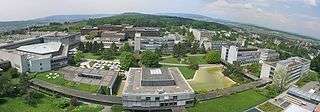
ETH Zurich has two campuses. The main building was constructed 1858–1864 outside and right above the eastern border of the town, but nowadays it is located right in the heart of the city. As the town and university grew, the ETH spread into the surrounding vineyards and later quarters. As a result, the Zentrum campus consists of various buildings and institutions throughout Zürich and firmly integrates the ETH in the city. The main building stands directly across the street from the University Hospital of Zurich and the University of Zurich.
Because this geographic situation substantially hindered the expansion of ETH, a new campus was built from 1964 to 1976 on the Hönggerberg on a northern hill in the outskirts of the city. The last major expansion project of this new campus was completed in 2003; since then, the Hönggerberg location houses the departments of architecture, civil engineering, biology, chemistry, materials science and physics.
Main building

The main building of ETH was built from 1858 to 1864 under Gustav Zeuner; the architect, however, was Gottfried Semper, who was a professor of architecture at ETH at the time and one of the most important architectural writers and theorists of the age. Semper worked in a neoclassical style that was unique to him; and the namesake and architect of the Semperoper in Dresden. It emphasized bold and clear massings with a detailing, such as the rusticated ground level and giant order above, that derived in part from the work of Andrea Palladio and Donato Bramante. During the construction of the University of Zürich, the south wing of the building was allocated to the University until its own new main building was constructed (1912–1914). At about the same time, Semper's ETH building was enlarged and received its impressive cupola.
Science City
In the year of ETH Zurich's 150th anniversary, an extensive project called "Science City" for the Hönggerberg Campus was started with the goal to transform the campus into an attractive district based on the principle of sustainability.
In September 2014 a new project to connect Science City by train was published.[25]
ETH Laboratory of Ion Beam Physics
The ETH Laboratory of Ion Beam Physics (LIB) is a physics laboratory located in Science City. It specializes in accelerator mass spectrometry (AMS) and the use of ion beam based techniques with applications in archeology, earth sciences, life sciences, material sciences and fundamental physics. An example of such application is the tracing of isotopes and the detection of rare radionuclides with radiocarbon dating and the use of techniques such as Rutherford backscattering spectrometry or elastic recoil detection.[26] The LIB is developing the next generation of AMS machines. It is also a laboratory available for users interested in applying the techniques of ion beam analysis.[27]
Student life
ETH students were found to be the busiest students of all institutions of higher education in Switzerland.[28] The undergraduates' tight curriculum consists of as much as twice the number of lectures as comparable courses of other Swiss universities.
ETH has well over 100 student associations. Most notable is the VSETH (Verband der Studierenden an der ETH) which comprises all department associations. The associations regularly organize events with varying size and popularity. Events of the neighboring University of Zürich are well-attended by ETH students and vice versa. The VSETH organizes events of greater public attention, such as the Polyball, the Polyparty (does not exist any more) and the Erstsemestrigenfest, the first two housed in the main building of ETH. Sometimes, the annual Erstsemestrigenfest takes place at extraordinary locations, for example the Zurich Airport. All freshmen enjoy special treatment at that event.
Some of the notable associations that are not affiliated with a specific department are the ETH Entrepreneur Club and ETH Model United Nations. Both organisations enjoy high international standings and are regularly awarded for excellence in their field. ETH Juniors is another student-run organisation. It forms a bridge between industry and the ETH and offers many services for students and companies alike.[29]
The Academic Sports Association of Zürich (ASVZ) offers more than 120 sports.[30] The biggest annual sports event is the SOLA-Stafette (SOLA relay race) which consists of 14 sections over a total distance of 140 kilometers. More than 760 teams participated in the 2009 edition.[31] The 40th edition of the SOLA, held on 4 May 2013, had 900 enrolled teams, of which 893 started and 876 were classified.[32] In 2014 ASVZ celebrated their 75th anniversary.[33]
Traditions
The annual Polyball is the most prestigious public event at ETH, with a long tradition since the 1880s. At the end of November, the Polyball welcomes around 10,000 dancers, music-lovers and partygoers in the extensively decorated main building of ETH. This is the biggest decorated ball in Europe.
The amicable rivalry between ETH and the neighbouring University of Zürich has been cultivated since 1951 (Uni-Poly). There has been an annual rowing match between teams from the two institutions on the river Limmat.
There are many regular symposia and conferences at ETH, most notably the annual Wolfgang Pauli Lectures, in honor of former ETH Professor Wolfgang Pauli. Distinct lecturers, among them 24 Nobel laureates, have held lectures of the various fields of natural sciences at this conference since 1962.
Notable alumni and faculty
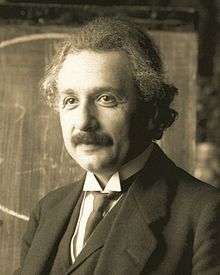
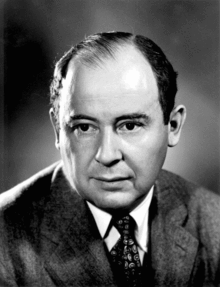
The names listed below are taken from the official record compiled by the ETH. It includes only graduates of the ETH and professors who have been awarded the Nobel Prize for their achievements at ETH.[35]
Nobel Prize in Physics
- 1901 Wilhelm Conrad Röntgen (graduate)
- 1920 Charles-Edouard Guillaume (graduate)
- 1921 Albert Einstein (student and professor)
- 1943 Otto Stern (lecturer)
- 1945 Wolfgang Pauli (professor)
- 1952 Felix Bloch (graduate)
- 1986 Heinrich Rohrer (graduate)
- 1987 Georg Bednorz (graduate)
- 1987 Karl Alexander Müller (graduate)
Nobel Prize in Chemistry
- 1913 Alfred Werner (graduate)
- 1915 Richard Martin Willstätter (professor)
- 1918 Fritz Haber (attended for one semester)
- 1936 Peter Debye (professor)
- 1938 Richard Kuhn (professor)
- 1939 Leopold Ružička (professor)
- 1953 Hermann Staudinger (lecturer)
- 1975 Vladimir Prelog (professor)
- 1991 Richard Ernst (graduate and professor)
- 2002 Kurt Wüthrich (professor)
- 2010 Richard F. Heck (postdoctoral student)
Nobel Prize in Medicine
- 1950 Tadeus Reichstein (graduate)
- 1978 Werner Arber (graduate)
Other Nobel laureates directly affiliated with the ETH
- 1912 Nils Gustaf Dalén (in collaboration with Aurel Stodola)
- 1943 George de Hevesy
- 1945 Artturi Ilmari Virtanen (in collaboration with Georg Wiegner)
- 1954 Max Born (in collaboration with Adolf Hurwitz)
- 1964 Konrad E. Bloch (in collaboration with Leopold Ružička and Vladimir Prelog)
- 1968 Lars Onsager (in collaboration with Peter Debye and Erich Hückel)
- 1968 Har Gobind Khorana (in collaboration with Vladimir Prelog)
- 1969 Max Delbrück (in collaboration with Wolfgang Pauli)
- 1987 Jean-Marie Lehn
ETH rectors
- Sarah Springman 1 January 2015
- Lino Guzzella 2013 – 31 December 2014
- Heidi Wunderli-Allenspach September 2007 - August 2013
- Konrad Osterwalder 1995 - September 2007
- Albin Herzog 1895-1899
ETH presidents
- Joël Mesot January 2019
- Lino Guzzella January 2015 - December 2018
- Ralph Eichler September 2007 – December 2014
- Konrad Osterwalder President Pro Tempore November 2006 – September 2007
- Ernst Hafen December 2005 – November 2006
ETH Zurich has produced and attracted many famous scientists in its short history, including Albert Einstein. More than twenty Nobel laureates have either studied at ETH or were awarded the Nobel Prize for their work achieved at ETH. Other alumni include scientists who were distinguished with the highest honours in their respective fields, amongst them Fields Medal, Pritzker Prize and Turing Award winners. Academic achievements aside, ETH has been alma mater to many Olympic medalists and world champions.
Related organizations
Collegium Helveticum
The Collegium Helveticum is an Institute for Advanced Study.[36] It is jointly supported and operated by the ETH Zurich, the University of Zurich and the Zurich University of the Arts. It is dedicated to transdisciplinary research and acts as a think tank as well. Fellows are elected for five years to work together on a particular subject. For the period 2016–2020, the research focus is on digital societies.[37]
ETH Zurich Foundation
The ETH Zurich Foundation is a legal entity on its own (a Swiss non-profit foundation) and as such not part of the ETH Zurich. Its purpose is to raise funds to support chosen institutes, projects, faculty and students at the ETH Zurich. It receives charitable donations from companies, foundations and private individuals. It can be compared with university endowments in the USA. However, the ETH Zurich is a public university so that the funds of this foundation are much smaller than at comparable private universities.[38] Examples of funded teaching and research are:[39]
- New institutes such as the Wyss Translational Center Zurich[40]
- Additional professorships
- Rössler Prize[41]
- Pioneer fellowships
- Excellence scholarships[42]
Military Academy
The Military Academy is an institution for the education, training and development of career officers of the Swiss Armed Forces. The scientific part of this organization is attached to the ETH Zurich, while other parts such as training and an assessment center are under the direct management of the defence sector of the Swiss Federal Government.[43]
Swiss National Supercomputing Center
The Swiss National Supercomputing Centre is an autonomous organizational unit of the ETH Zurich. It is a national facility based in Lugano-Cornaredo,[44] offering high-performance computing services for Swiss-based scientists.[45]
Gallery
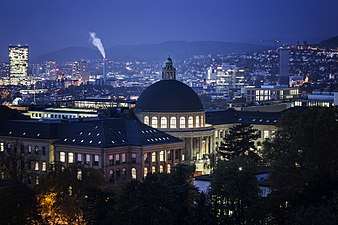 ETH at twilight
ETH at twilight HPT Tree in Winter
HPT Tree in Winter- Hönggerberg
 ETH–Universitätsspital tram stop
ETH–Universitätsspital tram stop
See also
| Wikimedia Commons has media related to ETH Zurich. |
- École Polytechnique Fédérale de Lausanne (Swiss Federal Institute of Technology in Lausanne, EPFL)
- Engineering
- Laboratory for Energy Conversion
- List of universities in Switzerland
- List of largest universities by enrollment in Switzerland
- List of forestry universities and colleges
- Science and technology in Switzerland
- 2000-watt society
- Disney Research
- e-rara.ch
- Swiss Electromagnetics Research and Engineering Centre
- ETH Zurich University Archives
- Category:ETH Zurich alumni
- Category:ETH Zurich faculty
Notes and references
- "1848–1855: The polytechnical realisation of a long-held dream". ETH Zürich. Retrieved 5 February 2018.
- "Annual Report 2017". Zurich, Switzerland: ETH Zurich. May 2018. Retrieved 20 June 2018.
- "Colour". Retrieved 2 March 2019.
- "Bericht über den Entwurf zu einem Reglemente für die Eidgenössische polytechnische Schule" (PDF). Schweizerisches Bundesblatt. Berne, Switzerland: Swiss Federal Council. 6 (39, Bd. 3): 163–182. 21 June 1854 – via ethistory.ethz.ch.
- "ETH Board - Governance ETH Domain". eth-rat.ch. Retrieved 1 November 2013.
- "QS World University Rankings 2021". Top Universities. 28 May 2020. Retrieved 10 June 2020.
- "World University Rankings 2020 by subject: engineering and technology". Times Higher Education (THE). 4 October 2019. Retrieved 10 June 2020.
- "Engineering and Technology". Top Universities. 26 February 2020. Retrieved 10 June 2020.
- "Earth & Marine Sciences". Top Universities. 25 February 2020. Retrieved 10 June 2020.
- "Portrait". ethz.ch. Retrieved 21 November 2019.
- "ETHistory 1855-2005". ETHistory. ETH Zurich. 2005. Retrieved 19 July 2015.
- "1848-1855: Polytechnical realization of an old dream". ETHistory. ETH Zurich. 31 March 2005. Retrieved 5 February 2018.
- "ETH Domain". Zurich and Berne, Switzerland: ETH Board. Retrieved 23 February 2015.
- "Academic Ranking of World Universities 2019". ShanghaiRanking. Retrieved 25 December 2019.
- "World University Rankings 2020 - ETH Zurich". Times Higher Education (THE). Retrieved 25 December 2019.
- "U.S. News Education: Best Global Universities 2019 - Swiss Federal Institute of Technology Zurich". Retrieved 25 December 2019.
- "QS World University Rankings 2020". Top Universities. Retrieved 25 December 2019.
- "ALBERT EINSTEIN (1879 – 1955)". Zuerich.
- "QS World University Rankings". Top Universities. QS Quacquarelli Symonds. Retrieved 16 June 2018.
- "QS World University Rankings by Subject 2016 - Earth & Marine Sciences". Top Universities. QS Quacquarelli Symonds. Retrieved 14 September 2016.
- "ETH Zurich – Swiss Federal Institute of Technology Zurich". Times Higher Education. Retrieved 19 July 2015.
- "Admission to the first semester with a Swiss matriculation certificate ("Matura")". ETH Zurich. Retrieved 4 April 2014.
- "Admission to first semester without Swiss matriculation certificate". ETH Zurich. Retrieved 4 April 2014.
- "Language requirements". ETH Zurich. Retrieved 4 April 2014.
- "Tunnelbahnhof für "Science City"" (PDF). www.adf-innovation.com (in German).
- "The world of Ion Beam Physics". overview. ETH Zurich. September 2010. Retrieved 5 September 2010.
- "Laboratory for Ion Physics". ETH Zurich, Department of Physics. September 2010. Retrieved 5 September 2010.
- "Willkommen auf Students.ch" (in German)
- "ETH Juniors". Retrieved 29 August 2017.
- "Academic Sports Association Zurich". Retrieved 25 January 2017.
- SOLA-Stafette 2009
- SOLA - Erfolgreiche Jubiläumsstafette
- "ASVZ". Archived from the original on 1 August 2015. Retrieved 19 July 2015.
- Ed Regis (8 November 1992). "Johnny Jiggles the Planet". The New York Times. Retrieved 4 February 2008.
- "Die ETH Zürich". Retrieved 19 July 2015.
- Collegium Helveticum. eurias Network of French Institutes for Advanced Study. Retrieved 4 August 2019
- Website Collegium Helveticum. Retrieved 4 August 2019
- René Donzé: ETH sucht Sponsoren in Deutschland. Neue Zürcher Zeitung am Sonntag, 7 April 2018. Retrieved 4 August 2019
- Website ETH Foundation. Retrieved 4 August 2019
- ETH and University of Zurich launch Wyss Translational Center. ETH Zurich, 12 December 2014. Retrieved 4 August 2019
- Rössler Prize. ETH Foundation. Retrieved 4 August 2019
- Ruf Lanz: Albert Einstein wirbt für Exzellenz-Stipendien. persoenlich.com, 19 november 2018. Retrieved 4 August 2019
- Military Academy (MILAC). Website Military Academy, Swiss Armed Forces. Retrieved 4 August 2019
- "CSCS moves into new computer centre in Lugano". CSCS. Retrieved 28 April 2020.
- Swiss National Supercomputing Center. Retrieved 4 August 2019
Further reading
- David Gugerli, Patrick Kupper, Daniel Speich (2005), Die Zukunftsmaschine. Konjunkturen der ETH Zürich 1855-2005. (in German), Zurich, Switzerland: CHRONOS – via www.ethistory.ethz.chCS1 maint: uses authors parameter (link)